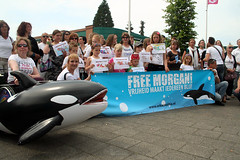A 2012 survey reported in the UK’s The Guardian newspaper makes very interesting
reading on a number of levels. It was
reporting on a survey carried out by the animal-rights lobby group The International Fund for Animal Welfare (IFAW) in regards to the Japanese’s
attitude to whaling and the consumption of whale products. The poll was commissioned and undertaken by
the Nippon Research Centre - a total of 1,200 people were surveyed aged 15 to 79
across all geographical areas in the country.
The
survey found that 26.8% of people agreed with Japan's hunting of about 900
whales each year whilst 18.5% opposed the hunts - the rest were undecided. Of those polled 88.8% had not bought whale
meat in the past 12 months. The IFAW
tried hard to make a positive spin on this last statistic by declaring in a press briefing: "The people of Japan are taking whale meat off the
menu”. But as always this issue is far
more complex and the poll seems actually to suggest a total failure on the part
of the animal-rights and environmental lobby to persuade the Japanese to stop
hunting whales – which also should include the smaller cetaceans such as
dolphins.
The
question to be asked is why this has happened after years of lobbying and one
answer could be that the lobbyists, particularly the animal-rights groups, have
produced confusing and mixed messages not helped by a rabid opposition to
perhaps a huge and potential allay in the guise of the international zoological
display community.
Perhaps
one of the most insidious examples of misdirection by the lobbyists was the
“award winning” 2009 film The Cove.
Whilst certainly not the first to reveal the dolphin and whale drive
hunts in Japan, the film renewed and galvanise public opinion on the
matter.
However,
it did unfortunately spend a large amount of time side-tracking away from the
bloody killing of the dolphins and small whales driven into the cove to highlight the
small number of animals that escape death by being selected for sale to mainly
Asian aquariums and parks. Reviewing any
press release or web page produced by the many and various groups lobbying
against the drive hunt one could be forgiven to think that live-capture was the
primary objective of the hunt not food or “pest control” (as some local
fisherman have called it). This despite
many zoos and aquariums having made clear position statements against the hunts in the past.
More details of this debate can be found HERE.
More details of this debate can be found HERE.
It
is not, of course, any small chance that one of the primary movers and shakers
in the The Cove was former 1960’s dolphin trainer and now animal-rights
activist Ric O’Barry whose anti-captive agenda over-arched the film to such an
extent that the real tragedy of the hunting of these thousands of animals was a
foot-note to his (and the producers) erroneous claims that the objective driving
the slaughter was the “aquarium industry”. This despite the fact that the hunt has been undertaken for hundreds of years with the
issue of acquiring animals for captive displays relatively a new phenomena only a
couple of decades old. Is it no wonder
that the central message - the bloody killing of thousands of animals - has become lost to the general public in Japan and elsewhere in pursuit of an anti-captive agenda by the animal-rights industry.
In
1992, the BBC Nature programme presented a programme featuring the whale hunts
and an investigation by the environmental group the The Environmental Investigation Agency (EIA). They wanted to discover
what actually was happen to whale meat in Japan.
Their
conclusions were very different from the conclusion of the recent survey by
IFAW. They found that whale meat consumption was not
high but this was due to the sheer expense of the product with the general Japanese
public only consuming it in any quantities when it was place of special
offer. Perhaps more alarming was the
fate of the small whales and dolphins killed in the various drive fisheries
which their undercover investigation revealed were being sold as “whale meat”. During the course of the programme alternative
revenue generation and public education to the merits of cetaceans as living natural
resources was explored and the subject of whale watching was discussed. Interestingly, this included not only coastal
watching by boat but also the observation of animals with zoological collections
- a point now so vilified by operators and supporters of the animal-rights industry.
It
seems things really have not changed since the 1990’s for the animals killed
each year in drive hunts except for the few who may find their way into an aquarium
or zoo. It could be suggested that it would be a bit more logical if those who sincerely want to see an end to drive hunts should actually
focus on the realities of the issues rather than get side-tracked into the
personal agendas of a small but influential groups of animal-rights activist with personal
axes the grind regarding cetceans in captive care which if actually banned tomorrow would not stop the drive hunt slaughter and could (by depriving
some people direct contact with animals in zoos and aquariums) take away one of the avenues of direct communication needed to make a difference to thousands of animal butchered annually
in Japan.







